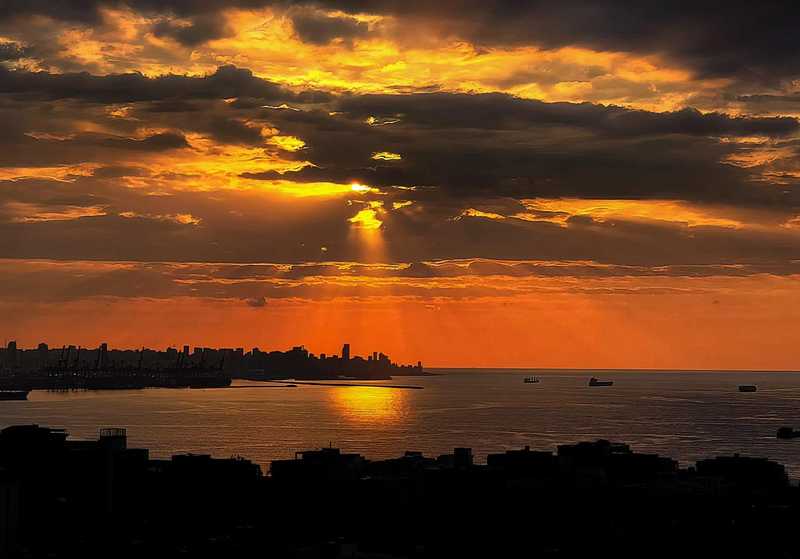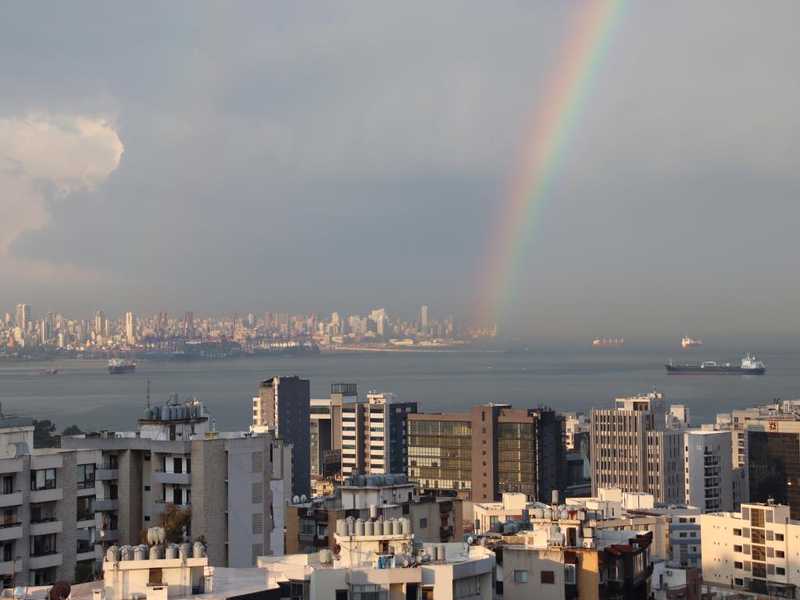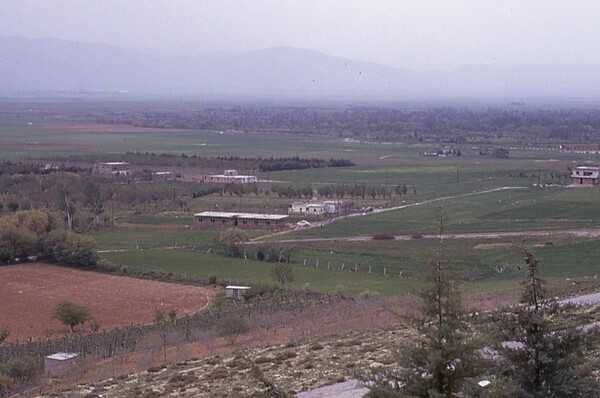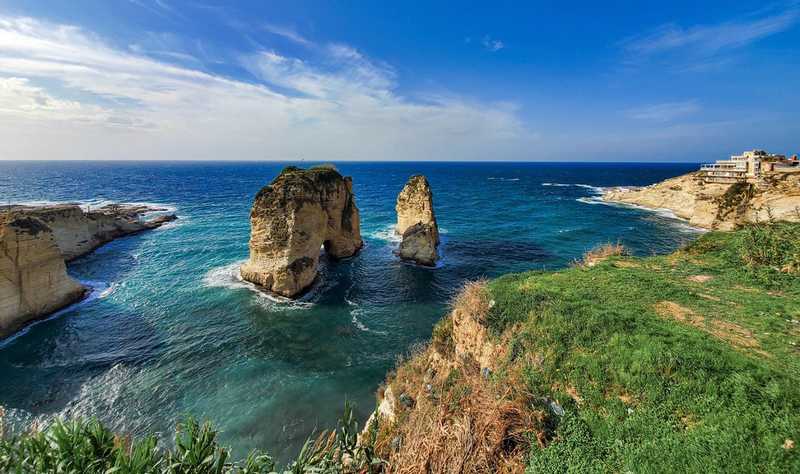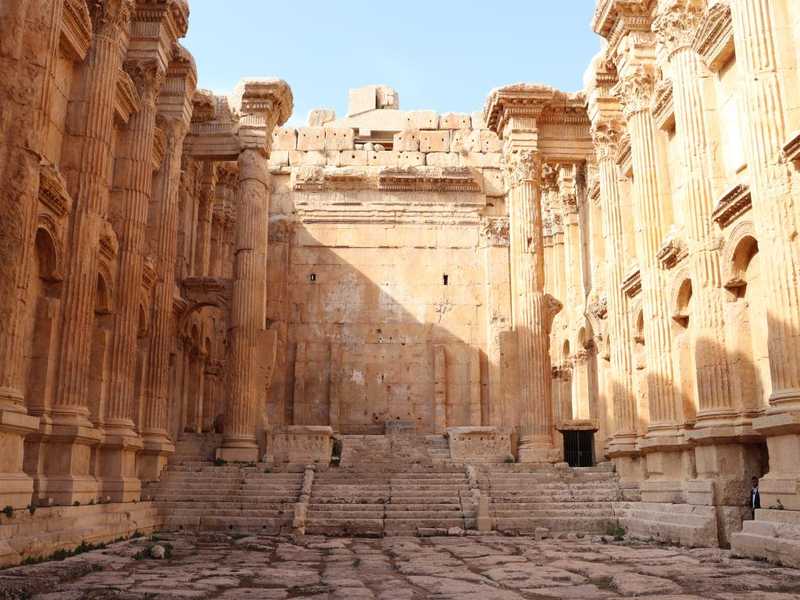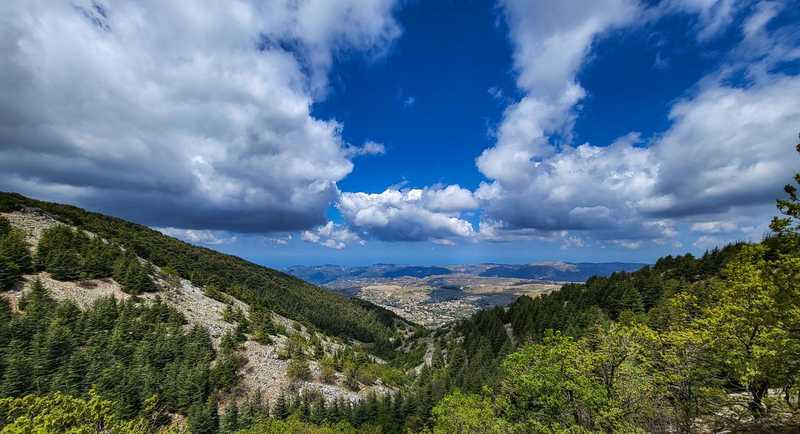Lebanon - LB - LBN - LBN - Middle East
Last updated: January 05, 2026

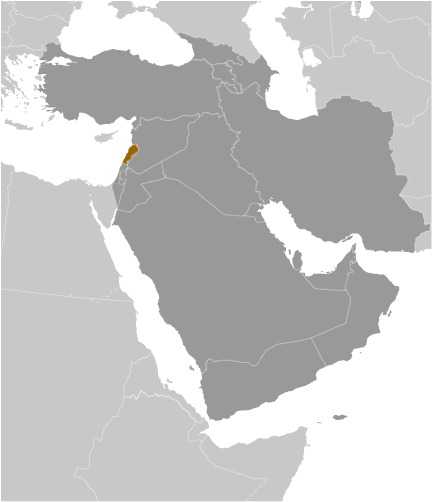

Lebanon Images
Lebanon Factbook Data
Diplomatic representation from the US
chief of mission: Ambassador Michel ISSA (since 17 November 2025)
embassy: Awkar facing the Municipality
P.O. Box 70-840 Antelias, Beirut
mailing address: 6070 Beirut Place, Washington DC 20521-6070
telephone: [961] (04) 543-600
FAX: [961] (4) 544-019
email address and website:
BeirutACS@state.gov
https://lb.usembassy.gov/
embassy: Awkar facing the Municipality
P.O. Box 70-840 Antelias, Beirut
mailing address: 6070 Beirut Place, Washington DC 20521-6070
telephone: [961] (04) 543-600
FAX: [961] (4) 544-019
email address and website:
BeirutACS@state.gov
https://lb.usembassy.gov/
Age structure
0-14 years: 18.9% (male 519,352/female 495,591)
15-64 years: 71.6% (male 1,939,311/female 1,900,574)
65 years and over: 9.5% (2024 est.) (male 219,880/female 289,774)
15-64 years: 71.6% (male 1,939,311/female 1,900,574)
65 years and over: 9.5% (2024 est.) (male 219,880/female 289,774)
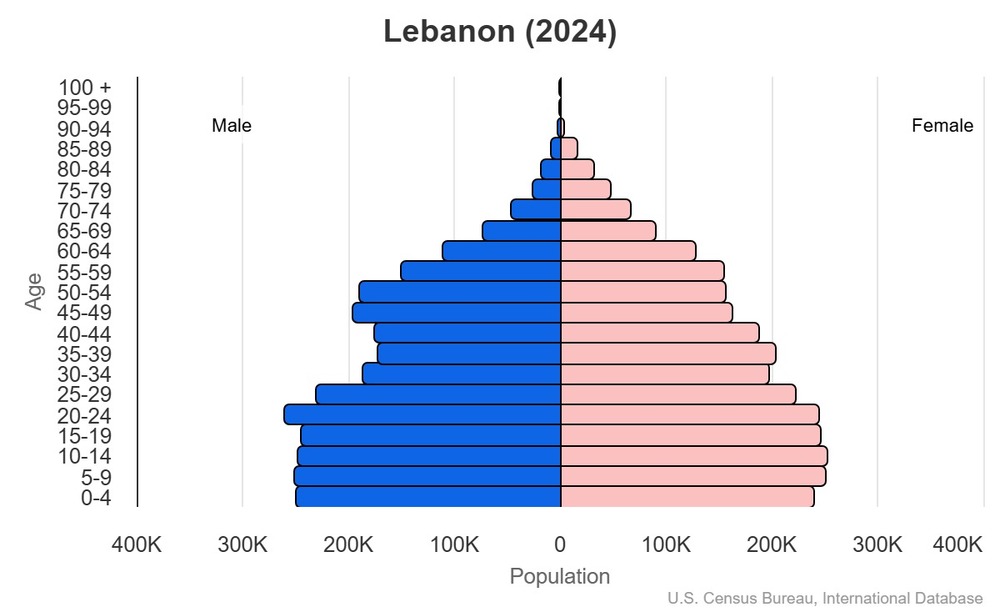
This is the population pyramid for Lebanon. A population pyramid illustrates the age and sex structure of a country's population and may provide insights about political and social stability, as well as economic development. The population is distributed along the horizontal axis, with males shown on the left and females on the right. The male and female populations are broken down into 5-year age groups represented as horizontal bars along the vertical axis, with the youngest age groups at the bottom and the oldest at the top. The shape of the population pyramid gradually evolves over time based on fertility, mortality, and international migration trends.
For additional information, please see the entry for Population pyramid on the Definitions and Notes page.
For additional information, please see the entry for Population pyramid on the Definitions and Notes page.
Geographic coordinates
33 50 N, 35 50 E
Sex ratio
at birth: 1.05 male(s)/female
0-14 years: 1.05 male(s)/female
15-64 years: 1.02 male(s)/female
65 years and over: 0.76 male(s)/female
total population: 1 male(s)/female (2024 est.)
0-14 years: 1.05 male(s)/female
15-64 years: 1.02 male(s)/female
65 years and over: 0.76 male(s)/female
total population: 1 male(s)/female (2024 est.)
Natural hazards
earthquakes; dust storms, sandstorms
Area - comparative
about one-third the size of Maryland
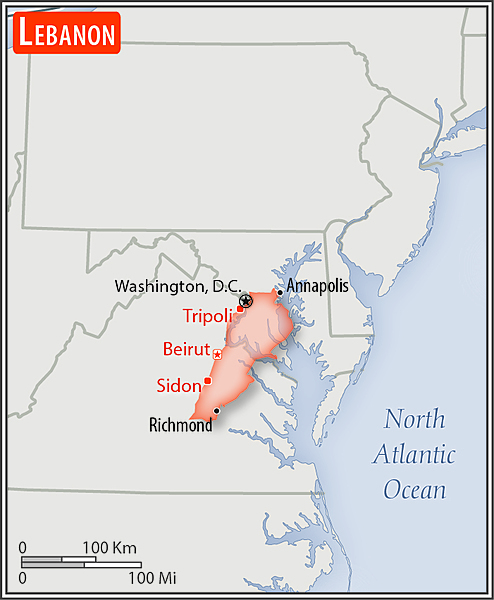
about one-third the size of Maryland
Military service age and obligation
17-25 years of age for men and women for voluntary military service; no conscription (2024)
note: women were allowed to volunteer for military service in the 1980s; as of 2023, they comprised about 5% of the active duty military
note: women were allowed to volunteer for military service in the 1980s; as of 2023, they comprised about 5% of the active duty military
Background
As a result of its location at the crossroads of three continents, the area that is modern-day Lebanon is rich in cultural and religious diversity. This region was subject to various foreign conquerors for much of its history, including the Romans, Arabs, and Ottomans. Following World War I, France acquired a mandate over the northern portion of the former Ottoman Empire province of Syria. From it the French demarcated the region of Lebanon in 1920, and it gained independence in 1943. Lebanon subsequently experienced periods of political turmoil interspersed with prosperity built on its position as a regional center for finance and trade.
The country's 1975-90 civil war, which resulted in an estimated 120,000 fatalities, was followed by years of social and political instability, and sectarianism remains a key element of Lebanese political life. The Israeli defense forces, which occupied parts of Lebanon during the civil war, did not completely withdraw until 2000. Neighboring Syria influenced Lebanon's foreign and domestic policies while its military occupied Lebanon from 1976 until 2005, but its influence diminished significantly after 2005. Over 1.5 million Syrian refugees fled to Lebanon after the start of the Syrian conflict in 2011. Hizballah -- a major Lebanese political party, militia, and US-designated foreign terrorist organization -- and Israel continued attacks and counterattacks against each other after Syria's withdrawal and fought a brief war in 2006. After HAMAS attacked Israel on 7 October 2023, the intensity and frequency of these cross-border attacks increased substantially into a cycle of hostilities, mostly limited to the border areas as of January 2024. Lebanon's borders with Syria and Israel remain unresolved.
Lebanon's prosperity has significantly diminished since the beginning of the country's economic crisis in 2019, which has crippled its economy, shut down its previously lucrative banking sector, reduced the value of its currency, and caused many Lebanese to emigrate in search of better prospects.
The country's 1975-90 civil war, which resulted in an estimated 120,000 fatalities, was followed by years of social and political instability, and sectarianism remains a key element of Lebanese political life. The Israeli defense forces, which occupied parts of Lebanon during the civil war, did not completely withdraw until 2000. Neighboring Syria influenced Lebanon's foreign and domestic policies while its military occupied Lebanon from 1976 until 2005, but its influence diminished significantly after 2005. Over 1.5 million Syrian refugees fled to Lebanon after the start of the Syrian conflict in 2011. Hizballah -- a major Lebanese political party, militia, and US-designated foreign terrorist organization -- and Israel continued attacks and counterattacks against each other after Syria's withdrawal and fought a brief war in 2006. After HAMAS attacked Israel on 7 October 2023, the intensity and frequency of these cross-border attacks increased substantially into a cycle of hostilities, mostly limited to the border areas as of January 2024. Lebanon's borders with Syria and Israel remain unresolved.
Lebanon's prosperity has significantly diminished since the beginning of the country's economic crisis in 2019, which has crippled its economy, shut down its previously lucrative banking sector, reduced the value of its currency, and caused many Lebanese to emigrate in search of better prospects.
Environmental issues
deforestation; soil deterioration, erosion; desertification; species loss; air pollution in Beirut from vehicular traffic and the burning of industrial wastes; pollution of coastal waters from raw sewage and oil spills; waste-water management
International environmental agreements
party to: Biodiversity, Climate Change, Climate Change-Kyoto Protocol, Climate Change-Paris Agreement, Comprehensive Nuclear Test Ban, Desertification, Endangered Species, Hazardous Wastes, Law of the Sea, Nuclear Test Ban, Ozone Layer Protection, Ship Pollution, Wetlands
signed, but not ratified: Environmental Modification, Marine Life Conservation
signed, but not ratified: Environmental Modification, Marine Life Conservation
Military expenditures
2.9% of GDP (2022 est.)
3.2% of GDP (2021 est.)
3% of GDP (2020 est.)
4.7% of GDP (2019 est.)
5.1% of GDP (2018 est.)
3.2% of GDP (2021 est.)
3% of GDP (2020 est.)
4.7% of GDP (2019 est.)
5.1% of GDP (2018 est.)
Exports - commodities
jewelry, cars, diamonds, scrap iron, gold (2023)
note: top five export commodities based on value in dollars
note: top five export commodities based on value in dollars
Exports - partners
UAE 26%, Egypt 7%, Turkey 5%, Iraq 5%, USA 4% (2023)
note: top five export partners based on percentage share of exports
note: top five export partners based on percentage share of exports
Administrative divisions
8 governorates (mohafazat, singular - mohafazah); Aakkar, Baalbek-Hermel, Beqaa (Bekaa), Beyrouth (Beirut), Liban-Nord (North Lebanon), Liban-Sud (South Lebanon), Mont-Liban (Mount Lebanon), Nabatiye
Agricultural products
potatoes, milk, tomatoes, apples, oranges, olives, cucumbers/gherkins, chicken, lemons/limes, wheat (2023)
note: top ten agricultural products based on tonnage
note: top ten agricultural products based on tonnage
Military and security forces
Lebanese Armed Forces (LAF): Army Command (includes Presidential Guard Brigade, Land Border Regiments), Naval Forces, Air Forces
Ministry of Interior: General Directorate of Internal Security Forces (law enforcement; includes Mobile Gendarmerie), General Directorate for Public Security (border control, some domestic security duties) (2025)
note: the commander of the LAF is also the head of the Army; the LAF patrols external borders, while official border checkpoints are under the authority of Directorate for General Security
Ministry of Interior: General Directorate of Internal Security Forces (law enforcement; includes Mobile Gendarmerie), General Directorate for Public Security (border control, some domestic security duties) (2025)
note: the commander of the LAF is also the head of the Army; the LAF patrols external borders, while official border checkpoints are under the authority of Directorate for General Security
Budget
revenues: $12.73 billion (2021 est.)
expenditures: $11.853 billion (2021 est.)
note: central government revenues and expenses (excluding grants/extrabudgetary units/social security funds) converted to US dollars at average official exchange rate for year indicated
expenditures: $11.853 billion (2021 est.)
note: central government revenues and expenses (excluding grants/extrabudgetary units/social security funds) converted to US dollars at average official exchange rate for year indicated
Capital
name: Beirut
geographic coordinates: 33 52 N, 35 30 E
time difference: UTC+2 (7 hours ahead of Washington, DC, during Standard Time)
daylight saving time: +1hr, begins last Sunday in March; ends last Sunday in October
etymology: derived from the Phoenician or Hebrew word be'erot, meaning "the wells," which were the only source of water in the region
geographic coordinates: 33 52 N, 35 30 E
time difference: UTC+2 (7 hours ahead of Washington, DC, during Standard Time)
daylight saving time: +1hr, begins last Sunday in March; ends last Sunday in October
etymology: derived from the Phoenician or Hebrew word be'erot, meaning "the wells," which were the only source of water in the region
Imports - commodities
refined petroleum, gold, cars, packaged medicine, garments (2023)
note: top five import commodities based on value in dollars
note: top five import commodities based on value in dollars
Climate
Mediterranean; mild to cool, wet winters with hot, dry summers; the Lebanon Mountains experience heavy winter snows
Coastline
225 km
Constitution
history: drafted 15 May 1926, adopted 23 May 1926
amendment process: proposed by the president of the republic and introduced as a government bill to the National Assembly or proposed by at least 10 members of the Assembly and agreed upon by two thirds of its members; if proposed by the National Assembly, review and approval by two-thirds majority of the Cabinet is required; if approved, the proposal is next submitted to the Cabinet for drafting as an amendment; Cabinet approval requires at least two-thirds majority, followed by submission to the National Assembly for discussion and vote; passage requires at least two-thirds majority vote of a required two-thirds quorum of the Assembly membership and promulgation by the president
amendment process: proposed by the president of the republic and introduced as a government bill to the National Assembly or proposed by at least 10 members of the Assembly and agreed upon by two thirds of its members; if proposed by the National Assembly, review and approval by two-thirds majority of the Cabinet is required; if approved, the proposal is next submitted to the Cabinet for drafting as an amendment; Cabinet approval requires at least two-thirds majority, followed by submission to the National Assembly for discussion and vote; passage requires at least two-thirds majority vote of a required two-thirds quorum of the Assembly membership and promulgation by the president
Exchange rates
Lebanese pounds (LBP) per US dollar -
Exchange rates:
89,500 (2024 est.)
13,875.625 (2023 est.)
1,507.5 (2022 est.)
1,507.5 (2021 est.)
1,507.5 (2020 est.)
Exchange rates:
89,500 (2024 est.)
13,875.625 (2023 est.)
1,507.5 (2022 est.)
1,507.5 (2021 est.)
1,507.5 (2020 est.)
Executive branch
chief of state: President Joseph AOUN (since 9 January 2025)
head of government: Prime Minister Nawaf SALAM (since 8 February 2025)
cabinet: Cabinet chosen by the prime minister in consultation with the president and the National Assembly
election/appointment process: president indirectly elected by a qualified majority of two-thirds of Parliament members in the first round and, if needed, a two-thirds quorum of members by simple-majority popular vote for a 6-year term (eligible for non-consecutive terms); prime minister appointed by the president in consultation with the National Assembly
most recent election date: 9 January 2025
election results:
2025: Joseph AOUN elected president in second round; National Assembly vote - 99 of 128
2016: Michel AWN elected president in second round; National Assembly vote - Michel AWN (FPM) 83; the president elected in its 46th attempt on 31 October 2016
expected date of next election: 2031
head of government: Prime Minister Nawaf SALAM (since 8 February 2025)
cabinet: Cabinet chosen by the prime minister in consultation with the president and the National Assembly
election/appointment process: president indirectly elected by a qualified majority of two-thirds of Parliament members in the first round and, if needed, a two-thirds quorum of members by simple-majority popular vote for a 6-year term (eligible for non-consecutive terms); prime minister appointed by the president in consultation with the National Assembly
most recent election date: 9 January 2025
election results:
2025: Joseph AOUN elected president in second round; National Assembly vote - 99 of 128
2016: Michel AWN elected president in second round; National Assembly vote - Michel AWN (FPM) 83; the president elected in its 46th attempt on 31 October 2016
expected date of next election: 2031
Flag
description: three horizontal bands consisting of red (top), white (middle, double-width), and red (bottom), with a green cedar tree centered on the white band
meaning: red stands for blood shed for liberation, and white for peace, the snow of the mountains, and purity; the green cedar tree is the national symbol and represents eternity, steadiness, happiness, and prosperity
meaning: red stands for blood shed for liberation, and white for peace, the snow of the mountains, and purity; the green cedar tree is the national symbol and represents eternity, steadiness, happiness, and prosperity
Independence
22 November 1943 (from League of Nations mandate under French administration)
Industries
banking, tourism, real estate and construction, food processing, wine, jewelry, cement, textiles, mineral and chemical products, wood and furniture products, oil refining, metal fabricating
Judicial branch
highest court(s): Court of Cassation or Supreme Court (organized into 8 chambers, each with a presiding judge and 2 associate judges); Constitutional Council (consists of 10 members)
judge selection and term of office: Court of Cassation judges appointed by Supreme Judicial Council, a 10-member body headed by the chief justice, and includes other judicial officials; judge tenure NA; Constitutional Council members appointed - 5 by the Council of Ministers and 5 by parliament; members serve 5-year terms
subordinate courts: Courts of Appeal; Courts of First Instance; specialized tribunals, religious courts; military courts
judge selection and term of office: Court of Cassation judges appointed by Supreme Judicial Council, a 10-member body headed by the chief justice, and includes other judicial officials; judge tenure NA; Constitutional Council members appointed - 5 by the Council of Ministers and 5 by parliament; members serve 5-year terms
subordinate courts: Courts of Appeal; Courts of First Instance; specialized tribunals, religious courts; military courts
Land boundaries
total: 484 km
border countries (2): Israel 81 km; Syria 403 km
border countries (2): Israel 81 km; Syria 403 km
Land use
agricultural land: 65.9% (2023 est.)
arable land: 13.1% (2023 est.)
permanent crops: 13.7% (2023 est.)
permanent pasture: 39.1% (2023 est.)
forest: 13.8% (2023 est.)
other: 20.3% (2023 est.)
arable land: 13.1% (2023 est.)
permanent crops: 13.7% (2023 est.)
permanent pasture: 39.1% (2023 est.)
forest: 13.8% (2023 est.)
other: 20.3% (2023 est.)
Legal system
mixed system of civil law based on the French civil code, Ottoman legal tradition, and religious laws covering personal status, marriage, divorce, and other family relations of the Jewish, Islamic, and Christian communities
Legislative branch
legislature name: National Assembly (Majlis Al-Nuwwab)
legislative structure: unicameral
number of seats: 128 (all directly elected)
electoral system: proportional representation
scope of elections: full renewal
term in office: 4 years
most recent election date: 5/15/2022
parties elected and seats per party: Strong Republic (19); Strong Lebanon (18); Development and Liberation (15); Loyalty to the Resistance (15); Independent Deputies (9); Democratic Gathering (8); Independents (20); Other (24)
percentage of women in chamber: 6.3%
expected date of next election: May 2026
note 1: Lebanon’s constitution states that the Parliament cannot conduct regular business until it elects a president when the position is vacant
note 2: seats are apportioned evenly between Christians and Muslims
legislative structure: unicameral
number of seats: 128 (all directly elected)
electoral system: proportional representation
scope of elections: full renewal
term in office: 4 years
most recent election date: 5/15/2022
parties elected and seats per party: Strong Republic (19); Strong Lebanon (18); Development and Liberation (15); Loyalty to the Resistance (15); Independent Deputies (9); Democratic Gathering (8); Independents (20); Other (24)
percentage of women in chamber: 6.3%
expected date of next election: May 2026
note 1: Lebanon’s constitution states that the Parliament cannot conduct regular business until it elects a president when the position is vacant
note 2: seats are apportioned evenly between Christians and Muslims
Literacy
total population: 92% (2019 est.)
male: 94.8% (2019 est.)
female: 89.5% (2019 est.)
male: 94.8% (2019 est.)
female: 89.5% (2019 est.)
Maritime claims
territorial sea: 12 nm
International organization participation
ABEDA, AFESD, AMF, CAEU, FAO, G-24, G-77, IAEA, IBRD, ICAO, ICC (national committees), ICRM, IDA, IDB, IFAD, IFC, IFRCS, ILO, IMF, IMO, IMSO, Interpol, IOC, IPU, ISO, ITSO, ITU, LAS, MIGA, NAM, OAS (observer), OIC, OIF, OPCW, PCA, UN, UNCTAD, UNESCO, UNHCR, UNIDO, UNRWA, UNWTO, UPU, WCO, WFTU (NGOs), WHO, WIPO, WMO, WTO (observer)
National holiday
Independence Day, 22 November (1943)
Nationality
noun: Lebanese (singular and plural)
adjective: Lebanese
adjective: Lebanese
Natural resources
limestone, iron ore, salt, water-surplus state in a water-deficit region, arable land
Geography - note
smallest country in continental Asia; Nahr el Litani is the only major river in Near East not crossing an international boundary
Economic overview
lower middle-income Middle Eastern economy; hyperinflation and sharp poverty increases; banks have ceased lending; economic contraction, destroyed infrastructure, and reduced consumer demand resulting from Israel-Hezbollah conflict
Political parties
Al-Ahbash (Association of Islamic Charitable Projects) or AICP
Amal Movement ("Hope Movement")
Azm Movement
Ba’th Arab Socialist Party of Lebanon
Free Patriotic Movement or FPM
Future Movement Bloc or FM
Hizballah
Islamic Action Front or IAF
Kata'ib Party
Lebanese Democratic Party
Lebanese Forces or LF
Marada Movement
Progressive Socialist Party or PSP
Social Democrat Hunshaqian Party
Syrian Social Nationalist Party or SSNP
Tashnaq or Armenian Revolutionary Federation
Amal Movement ("Hope Movement")
Azm Movement
Ba’th Arab Socialist Party of Lebanon
Free Patriotic Movement or FPM
Future Movement Bloc or FM
Hizballah
Islamic Action Front or IAF
Kata'ib Party
Lebanese Democratic Party
Lebanese Forces or LF
Marada Movement
Progressive Socialist Party or PSP
Social Democrat Hunshaqian Party
Syrian Social Nationalist Party or SSNP
Tashnaq or Armenian Revolutionary Federation
Railways
total: 401 km (2017)
standard gauge: 319 km (2017) 1.435-m gauge
narrow gauge: 82 km (2017) 1.050-m gauge
note: rail system is still unusable due to damage sustained from fighting in the 1980s and in 2006
standard gauge: 319 km (2017) 1.435-m gauge
narrow gauge: 82 km (2017) 1.050-m gauge
note: rail system is still unusable due to damage sustained from fighting in the 1980s and in 2006
Suffrage
21 years of age; authorized for all men and women regardless of religion; excludes persons convicted of felonies and other crimes or those imprisoned; excludes all military and security service personnel regardless of rank
Terrain
narrow coastal plain; El Beqaa (Bekaa Valley) separates Lebanon and Anti-Lebanon Mountains
Government type
parliamentary democratic republic
Country name
conventional long form: Lebanese Republic
conventional short form: Lebanon
local long form: Al Jumhuriyah al Lubnaniyah
local short form: Lubnan
former: Greater Lebanon
etymology: derives from the Semitic root lbn, meaning "white," and probably refers to the country's snow-capped mountains
conventional short form: Lebanon
local long form: Al Jumhuriyah al Lubnaniyah
local short form: Lubnan
former: Greater Lebanon
etymology: derives from the Semitic root lbn, meaning "white," and probably refers to the country's snow-capped mountains
Location
Middle East, bordering the Mediterranean Sea, between Israel and Syria
Map references
Middle East
Irrigated land
1,040 sq km (2012)
Diplomatic representation in the US
chief of mission: Ambassador Nada HAMADEH (since 5 September 2025)
chancery: 2560 28th Street NW, Washington, DC 20008
telephone: [1] (202) 939-6300
FAX: [1] (202) 939-6324
email address and website:
info@lebanonembassyus.org
http://www.lebanonembassyus.org/
consulate(s) general: Detroit, New York, Los Angeles
chancery: 2560 28th Street NW, Washington, DC 20008
telephone: [1] (202) 939-6300
FAX: [1] (202) 939-6324
email address and website:
info@lebanonembassyus.org
http://www.lebanonembassyus.org/
consulate(s) general: Detroit, New York, Los Angeles
Internet users
percent of population: 84% (2023 est.)
Internet country code
.lb
Refugees and internally displaced persons
refugees: 765,390 (2024 est.)
IDPs: 984,514 (2024 est.)
stateless persons: 40,000 (2024 est.)
IDPs: 984,514 (2024 est.)
stateless persons: 40,000 (2024 est.)
GDP (official exchange rate)
$20.079 billion (2023 est.)
note: data in current dollars at official exchange rate
note: data in current dollars at official exchange rate
Total renewable water resources
4.503 billion cubic meters (2022 est.)
School life expectancy (primary to tertiary education)
total: 11 years (2023 est.)
male: 12 years
female: 11 years (2014)
male: 12 years
female: 11 years (2014)
Urbanization
urban population: 89.4% of total population (2023)
rate of urbanization: -1.23% annual rate of change (2020-25 est.)
rate of urbanization: -1.23% annual rate of change (2020-25 est.)
Broadcast media
7 TV stations, 1 of which is state-owned; more than 30 radio stations, 1 of which is state-owned; satellite and cable TV services available; transmissions of at least 2 international broadcasters are accessible through partner stations (2019)
Drinking water source
improved:
total: 92.6% of population (2022 est.)
unimproved:
total: 7.4% of population (2022 est.)
total: 92.6% of population (2022 est.)
unimproved:
total: 7.4% of population (2022 est.)
National anthem(s)
title: "Kulluna lil-watan" (All of Us, For Our Country!)
lyrics/music: Rachid NAKHLE/Wadih SABRA
history: adopted 1927
lyrics/music: Rachid NAKHLE/Wadih SABRA
history: adopted 1927
This is an audio of the National Anthem for Lebanon. The national anthem is generally a patriotic musical composition - usually in the form of a song or hymn of praise - that evokes and eulogizes the history, traditions, or struggles of a nation or its people. National anthems can be officially recognized as a national song by a country's constitution or by an enacted law, or simply by tradition. Although most anthems contain lyrics, some do not.
Major urban areas - population
2.421 million BEIRUT (capital) (2023)
International law organization participation
has not submitted an ICJ jurisdiction declaration; non-party state to the ICCt
Physician density
2.68 physicians/1,000 population (2020)
Hospital bed density
2.7 beds/1,000 population (2021 est.)
National symbol(s)
cedar tree
GDP - composition, by end use
household consumption: 136% (2023 est.)
government consumption: 5.2% (2023 est.)
investment in fixed capital: 1.9% (2023 est.)
investment in inventories: 0% (2023 est.)
exports of goods and services: 30.6% (2023 est.)
imports of goods and services: -73.7% (2023 est.)
note: figures may not total 100% due to rounding or gaps in data collection
government consumption: 5.2% (2023 est.)
investment in fixed capital: 1.9% (2023 est.)
investment in inventories: 0% (2023 est.)
exports of goods and services: 30.6% (2023 est.)
imports of goods and services: -73.7% (2023 est.)
note: figures may not total 100% due to rounding or gaps in data collection
Dependency ratios
total dependency ratio: 50.3 (2024 est.)
youth dependency ratio: 39 (2024 est.)
elderly dependency ratio: 11.3 (2024 est.)
potential support ratio: 8.8 (2024 est.)
youth dependency ratio: 39 (2024 est.)
elderly dependency ratio: 11.3 (2024 est.)
potential support ratio: 8.8 (2024 est.)
Citizenship
citizenship by birth: no
citizenship by descent only: the father must be a citizen of Lebanon
dual citizenship recognized: yes
residency requirement for naturalization: unknown
citizenship by descent only: the father must be a citizen of Lebanon
dual citizenship recognized: yes
residency requirement for naturalization: unknown
Population distribution
the majority of people live on or near the Mediterranean coast, particularly in and around the capital of Beirut
Electricity access
electrification - total population: 100% (2022 est.)
Civil aircraft registration country code prefix
OD
Sanitation facility access
improved:
total: 100% of population (2022 est.)
unimproved:
total: 0% of population (2022 est.)
total: 100% of population (2022 est.)
unimproved:
total: 0% of population (2022 est.)
Ethnic groups
Arab 95%, Armenian 4%, other 1%
note: many Christian Lebanese do not identify as Arab but rather as descendants of the ancient Canaanites and prefer to be called Phoenicians
note: many Christian Lebanese do not identify as Arab but rather as descendants of the ancient Canaanites and prefer to be called Phoenicians
Religions
Muslim 67.8% (31.9% Sunni, 31.2% Shia, smaller percentages of Alawites and Ismailis), Christian 32.4% (Maronite Catholics are the largest Christian group), Druze 4.5%, very small numbers of Jews, Baha'is, Buddhists, and Hindus (2020 est.)
note: data represent the religious affiliation of the citizen population (data do not include Lebanon's sizable Syrian and Palestinian refugee populations); 18 religious sects recognized
note: data represent the religious affiliation of the citizen population (data do not include Lebanon's sizable Syrian and Palestinian refugee populations); 18 religious sects recognized
Languages
Arabic (official), French, English, Armenian
major-language sample(s):
كتاب حقائق العالم، المصدر الذي لا يمكن الاستغناء عنه للمعلومات الأساسية (Arabic)
The World Factbook, une source indispensable d'informations de base. (French)
The World Factbook, the indispensable source for basic information.
major-language sample(s):
كتاب حقائق العالم، المصدر الذي لا يمكن الاستغناء عنه للمعلومات الأساسية (Arabic)
The World Factbook, une source indispensable d'informations de base. (French)
The World Factbook, the indispensable source for basic information.
Arabic audio sample
French audio sample
Imports - partners
Switzerland 12%, China 11%, Greece 9%, Turkey 8%, Italy 6% (2023)
note: top five import partners based on percentage share of imports
note: top five import partners based on percentage share of imports
Elevation
highest point: Qornet es Saouda 3,088 m
lowest point: Mediterranean Sea 0 m
mean elevation: 1,250 m
lowest point: Mediterranean Sea 0 m
mean elevation: 1,250 m
Health expenditure
10.1% of GDP (2021)
15.5% of national budget (2022 est.)
15.5% of national budget (2022 est.)
Military - note
the primary responsibilities of the Lebanese Armed Forces (LAF) are defense against external attack, border security, protecting the country’s territorial waters, and assisting with internal security and development projects
the LAF’s domestic security responsibilities include countering narcotics trafficking and smuggling, managing protests, conducting search and rescue, and intervening to prevent violence between rival political factions; in recent years, the military has faced a financial crisis as government debt and national economic difficulties have undercut its ability to train and fully pay and supply personnel; the UN, as well as individual countries such as France, Qatar, and the US have provided financial assistance
the UN Interim Force in Lebanon (UNIFIL) has operated in the southern part of the country since 1978; it has approximately 10,500 personnel assigned and includes a maritime task force; the terrorist group Hizballah maintains thousands of fighters and militia in Lebanon, primarily in the south (see Terrorist Organizations in References) (2025)
the LAF’s domestic security responsibilities include countering narcotics trafficking and smuggling, managing protests, conducting search and rescue, and intervening to prevent violence between rival political factions; in recent years, the military has faced a financial crisis as government debt and national economic difficulties have undercut its ability to train and fully pay and supply personnel; the UN, as well as individual countries such as France, Qatar, and the US have provided financial assistance
the UN Interim Force in Lebanon (UNIFIL) has operated in the southern part of the country since 1978; it has approximately 10,500 personnel assigned and includes a maritime task force; the terrorist group Hizballah maintains thousands of fighters and militia in Lebanon, primarily in the south (see Terrorist Organizations in References) (2025)
Military and security service personnel strengths
approximately 70,000 active Lebanese Armed Forces (2025)
Terrorist group(s)
Terrorist group(s): Abdallah Azzam Brigades; al-Aqsa Martyrs Brigade; Asbat al-Ansar; HAMAS; Hizballah; Islamic Revolutionary Guard Corps (IRGC)/Qods Force; Islamic State of Iraq and ash-Sham (ISIS); Palestine Liberation Front (PLF); Popular Front for the Liberation of Palestine (PFLP); PFLP-General Command (PFLP-GC)
note: details about the history, aims, leadership, organization, areas of operation, tactics, targets, weapons, size, and sources of support of the group(s) appear(s) in the Terrorism reference guide
note: details about the history, aims, leadership, organization, areas of operation, tactics, targets, weapons, size, and sources of support of the group(s) appear(s) in the Terrorism reference guide
Total water withdrawal
municipal: 240 million cubic meters (2022 est.)
industrial: 900 million cubic meters (2022 est.)
agricultural: 700 million cubic meters (2022 est.)
industrial: 900 million cubic meters (2022 est.)
agricultural: 700 million cubic meters (2022 est.)
Waste and recycling
municipal solid waste generated annually: 2.04 million tons (2024 est.)
percent of municipal solid waste recycled: 15% (2022 est.)
percent of municipal solid waste recycled: 15% (2022 est.)
Average household expenditures
on food: 37.1% of household expenditures (2023 est.)
on alcohol and tobacco: 0.7% of household expenditures (2023 est.)
on alcohol and tobacco: 0.7% of household expenditures (2023 est.)
National heritage
Child marriage
women married by age 15: 1.4% (2016)
women married by age 18: 6% (2016)
women married by age 18: 6% (2016)
Coal
consumption: 166,000 metric tons (2023 est.)
exports: 47 metric tons (2022 est.)
imports: 164,000 metric tons (2023 est.)
exports: 47 metric tons (2022 est.)
imports: 164,000 metric tons (2023 est.)
Electricity generation sources
fossil fuels: 52.6% of total installed capacity (2023 est.)
solar: 31% of total installed capacity (2023 est.)
wind: 0.1% of total installed capacity (2023 est.)
hydroelectricity: 15.5% of total installed capacity (2023 est.)
biomass and waste: 0.7% of total installed capacity (2023 est.)
solar: 31% of total installed capacity (2023 est.)
wind: 0.1% of total installed capacity (2023 est.)
hydroelectricity: 15.5% of total installed capacity (2023 est.)
biomass and waste: 0.7% of total installed capacity (2023 est.)
Petroleum
refined petroleum consumption: 115,000 bbl/day (2023 est.)
Currently married women (ages 15-49)
52.4% (2019 est.)
Remittances
33.3% of GDP (2023 est.)
30.7% of GDP (2022 est.)
27.5% of GDP (2021 est.)
note: personal transfers and compensation between resident and non-resident individuals/households/entities
30.7% of GDP (2022 est.)
27.5% of GDP (2021 est.)
note: personal transfers and compensation between resident and non-resident individuals/households/entities
Ports
total ports: 5 (2024)
large: 1
medium: 1
small: 0
very small: 3
ports with oil terminals: 3
key ports: Bayrut, Sayda, Selaata, Sidon/zahrani Terminal, Tarabulus
large: 1
medium: 1
small: 0
very small: 3
ports with oil terminals: 3
key ports: Bayrut, Sayda, Selaata, Sidon/zahrani Terminal, Tarabulus
National color(s)
red, white, green
Particulate matter emissions
23.8 micrograms per cubic meter (2019 est.)
Methane emissions
energy: 7.9 kt (2022-2024 est.)
agriculture: 11.8 kt (2019-2021 est.)
waste: 105.3 kt (2019-2021 est.)
other: 0.7 kt (2019-2021 est.)
agriculture: 11.8 kt (2019-2021 est.)
waste: 105.3 kt (2019-2021 est.)
other: 0.7 kt (2019-2021 est.)
Labor force
1.939 million (2023 est.)
note: number of people ages 15 or older who are employed or seeking work
note: number of people ages 15 or older who are employed or seeking work
Youth unemployment rate (ages 15-24)
total: 23.6% (2023 est.)
male: 24.4% (2023 est.)
female: 21.9% (2023 est.)
note: % of labor force ages 15-24 seeking employment
male: 24.4% (2023 est.)
female: 21.9% (2023 est.)
note: % of labor force ages 15-24 seeking employment
Debt - external
$41.936 billion (2023 est.)
note: present value of external debt in current US dollars
note: present value of external debt in current US dollars
Maternal mortality ratio
15 deaths/100,000 live births (2023 est.)
Reserves of foreign exchange and gold
$33.301 billion (2024 est.)
$27.49 billion (2023 est.)
$32.513 billion (2022 est.)
note: holdings of gold (year-end prices)/foreign exchange/special drawing rights in current dollars
$27.49 billion (2023 est.)
$32.513 billion (2022 est.)
note: holdings of gold (year-end prices)/foreign exchange/special drawing rights in current dollars
Public debt
146.8% of GDP (2017 est.)
note: data cover central government debt and exclude debt instruments issued (or owned) by government entities other than the treasury; the data include treasury debt held by foreign entities; the data include debt issued by subnational entities, as well as intragovernmental debt; intragovernmental debt consists of treasury borrowings from surpluses in the social funds, such as for retirement, medical care, and unemployment
note: data cover central government debt and exclude debt instruments issued (or owned) by government entities other than the treasury; the data include treasury debt held by foreign entities; the data include debt issued by subnational entities, as well as intragovernmental debt; intragovernmental debt consists of treasury borrowings from surpluses in the social funds, such as for retirement, medical care, and unemployment
Unemployment rate
11.6% (2023 est.)
11.6% (2022 est.)
12.7% (2021 est.)
note: % of labor force seeking employment
11.6% (2022 est.)
12.7% (2021 est.)
note: % of labor force seeking employment
Population
total: 5,364,482 (2024 est.)
male: 2,678,543
female: 2,685,939
male: 2,678,543
female: 2,685,939
Carbon dioxide emissions
17.484 million metric tonnes of CO2 (2023 est.)
from coal and metallurgical coke: 375,000 metric tonnes of CO2 (2023 est.)
from petroleum and other liquids: 17.109 million metric tonnes of CO2 (2023 est.)
from coal and metallurgical coke: 375,000 metric tonnes of CO2 (2023 est.)
from petroleum and other liquids: 17.109 million metric tonnes of CO2 (2023 est.)
Area
total : 10,400 sq km
land: 10,230 sq km
water: 170 sq km
land: 10,230 sq km
water: 170 sq km
Taxes and other revenues
5.7% (of GDP) (2021 est.)
note: central government tax revenue as a % of GDP
note: central government tax revenue as a % of GDP
Real GDP (purchasing power parity)
$65.415 billion (2023 est.)
$65.917 billion (2022 est.)
$66.329 billion (2021 est.)
note: data in 2021 dollars
$65.917 billion (2022 est.)
$66.329 billion (2021 est.)
note: data in 2021 dollars
Airports
8 (2025)
Telephones - mobile cellular
total subscriptions: 4.29 million (2021 est.)
subscriptions per 100 inhabitants: 77 (2021 est.)
subscriptions per 100 inhabitants: 77 (2021 est.)
Inflation rate (consumer prices)
45.2% (2024 est.)
221.3% (2023 est.)
171.2% (2022 est.)
note: annual % change based on consumer prices
221.3% (2023 est.)
171.2% (2022 est.)
note: annual % change based on consumer prices
Current account balance
-$5.643 billion (2023 est.)
-$7.265 billion (2022 est.)
-$4.556 billion (2021 est.)
note: balance of payments - net trade and primary/secondary income in current dollars
-$7.265 billion (2022 est.)
-$4.556 billion (2021 est.)
note: balance of payments - net trade and primary/secondary income in current dollars
Real GDP per capita
$11,300 (2023 est.)
$11,500 (2022 est.)
$11,600 (2021 est.)
note: data in 2021 dollars
$11,500 (2022 est.)
$11,600 (2021 est.)
note: data in 2021 dollars
Broadband - fixed subscriptions
total: 419,000 (2022 est.)
subscriptions per 100 inhabitants: 7 (2022 est.)
subscriptions per 100 inhabitants: 7 (2022 est.)
Tobacco use
total: 34.1% (2025 est.)
male: 43.8% (2025 est.)
female: 25.4% (2025 est.)
male: 43.8% (2025 est.)
female: 25.4% (2025 est.)
Obesity - adult prevalence rate
32% (2016)
Energy consumption per capita
43.105 million Btu/person (2023 est.)
Electricity
installed generating capacity: 5.161 million kW (2023 est.)
consumption: 4.077 billion kWh (2023 est.)
imports: 797 million kWh (2021 est.)
transmission/distribution losses: 436.839 million kWh (2023 est.)
consumption: 4.077 billion kWh (2023 est.)
imports: 797 million kWh (2021 est.)
transmission/distribution losses: 436.839 million kWh (2023 est.)
Merchant marine
total: 51 (2023)
by type: bulk carrier 2, container ship 1, general cargo 30, oil tanker 1, other 17
by type: bulk carrier 2, container ship 1, general cargo 30, oil tanker 1, other 17
Children under the age of 5 years underweight
5.1% (2023 est.)
Imports
$23.313 billion (2023 est.)
$24.536 billion (2022 est.)
$17.667 billion (2021 est.)
note: balance of payments - imports of goods and services in current dollars
$24.536 billion (2022 est.)
$17.667 billion (2021 est.)
note: balance of payments - imports of goods and services in current dollars
Exports
$11.77 billion (2023 est.)
$12.445 billion (2022 est.)
$9.684 billion (2021 est.)
note: balance of payments - exports of goods and services in current dollars
$12.445 billion (2022 est.)
$9.684 billion (2021 est.)
note: balance of payments - exports of goods and services in current dollars
Heliports
27 (2025)
Telephones - fixed lines
total subscriptions: 875,000 (2021 est.)
subscriptions per 100 inhabitants: 16 (2022 est.)
subscriptions per 100 inhabitants: 16 (2022 est.)
Alcohol consumption per capita
total: 1.14 liters of pure alcohol (2019 est.)
beer: 0.38 liters of pure alcohol (2019 est.)
wine: 0.21 liters of pure alcohol (2019 est.)
spirits: 0.53 liters of pure alcohol (2019 est.)
other alcohols: 0.02 liters of pure alcohol (2019 est.)
beer: 0.38 liters of pure alcohol (2019 est.)
wine: 0.21 liters of pure alcohol (2019 est.)
spirits: 0.53 liters of pure alcohol (2019 est.)
other alcohols: 0.02 liters of pure alcohol (2019 est.)
Life expectancy at birth
total population: 79.2 years (2024 est.)
male: 77.8 years
female: 80.7 years
male: 77.8 years
female: 80.7 years
Real GDP growth rate
-0.8% (2023 est.)
-0.6% (2022 est.)
-7% (2021 est.)
note: annual GDP % growth based on constant local currency
-0.6% (2022 est.)
-7% (2021 est.)
note: annual GDP % growth based on constant local currency
Industrial production growth rate
0.1% (2023 est.)
note: annual % change in industrial value added based on constant local currency
note: annual % change in industrial value added based on constant local currency
GDP - composition, by sector of origin
agriculture: 1% (2023 est.)
industry: 2.1% (2023 est.)
services: 42.4% (2023 est.)
note: figures may not total 100% due to non-allocated consumption not captured in sector-reported data
industry: 2.1% (2023 est.)
services: 42.4% (2023 est.)
note: figures may not total 100% due to non-allocated consumption not captured in sector-reported data
Education expenditure
1.2% of GDP (2024 est.)
8.6% national budget (2025 est.)
8.6% national budget (2025 est.)
National coat of arms
Lebanon has had many coats of arms since declaring independence in 1943, but none were officially adopted. The current version is a variation of the national flag. Red stands for the blood shed for liberation, and white for peace, purity, and mountain snow. The cedar tree is the national symbol, embodying eternity, steadiness, happiness, and prosperity.
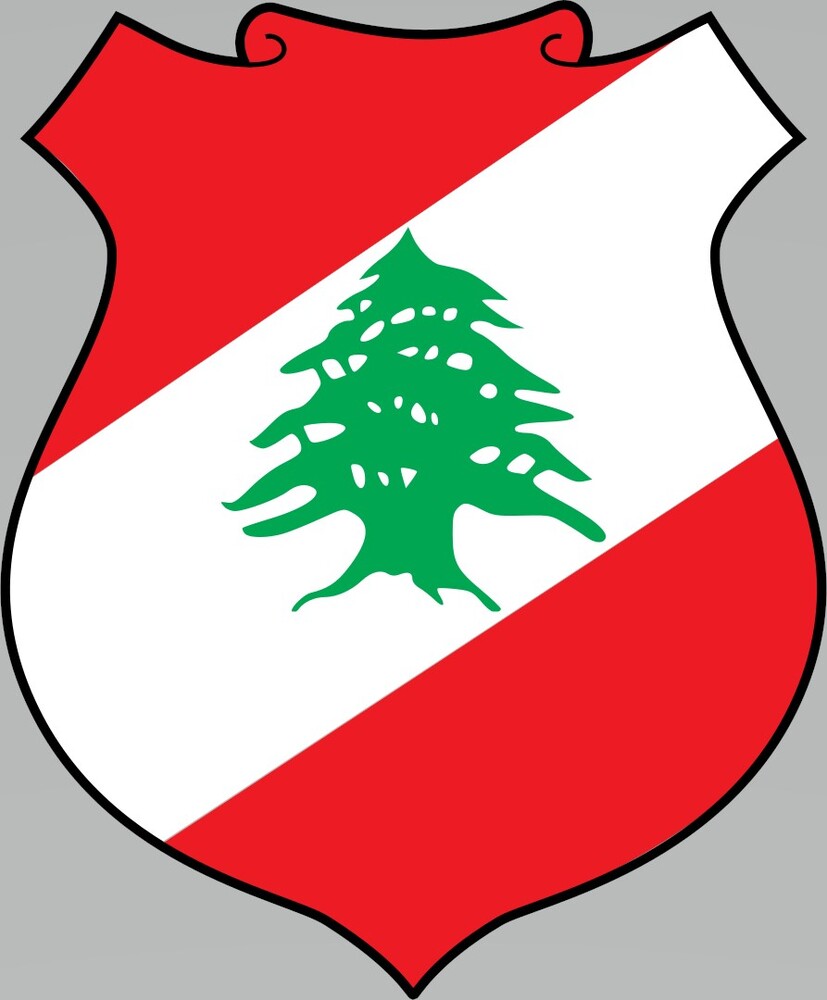
Lebanon has had many coats of arms since declaring independence in 1943, but none were officially adopted. The current version is a variation of the national flag. Red stands for the blood shed for liberation, and white for peace, purity, and mountain snow. The cedar tree is the national symbol, embodying eternity, steadiness, happiness, and prosperity.
Military equipment inventories and acquisitions
the LAF's inventory is comprised of mostly older or secondhand equipment from an array of countries, such as France, Germany, Russia, and especially the US (2025)
Gross reproduction rate
1.07 (2025 est.)
Net migration rate
-18.23 migrant(s)/1,000 population (2025 est.)
Median age
total: 29.4 years (2025 est.)
male: 35.6 years
female: 36.9 years
male: 35.6 years
female: 36.9 years
Total fertility rate
2.2 children born/woman (2025 est.)
Infant mortality rate
total: 7.3 deaths/1,000 live births (2025 est.)
male: 7.3 deaths/1,000 live births
female: 6.2 deaths/1,000 live births
male: 7.3 deaths/1,000 live births
female: 6.2 deaths/1,000 live births
Death rate
6.23 deaths/1,000 population (2025 est.)
Birth rate
16.73 births/1,000 population (2025 est.)
Population growth rate
-0.77% (2025 est.)

